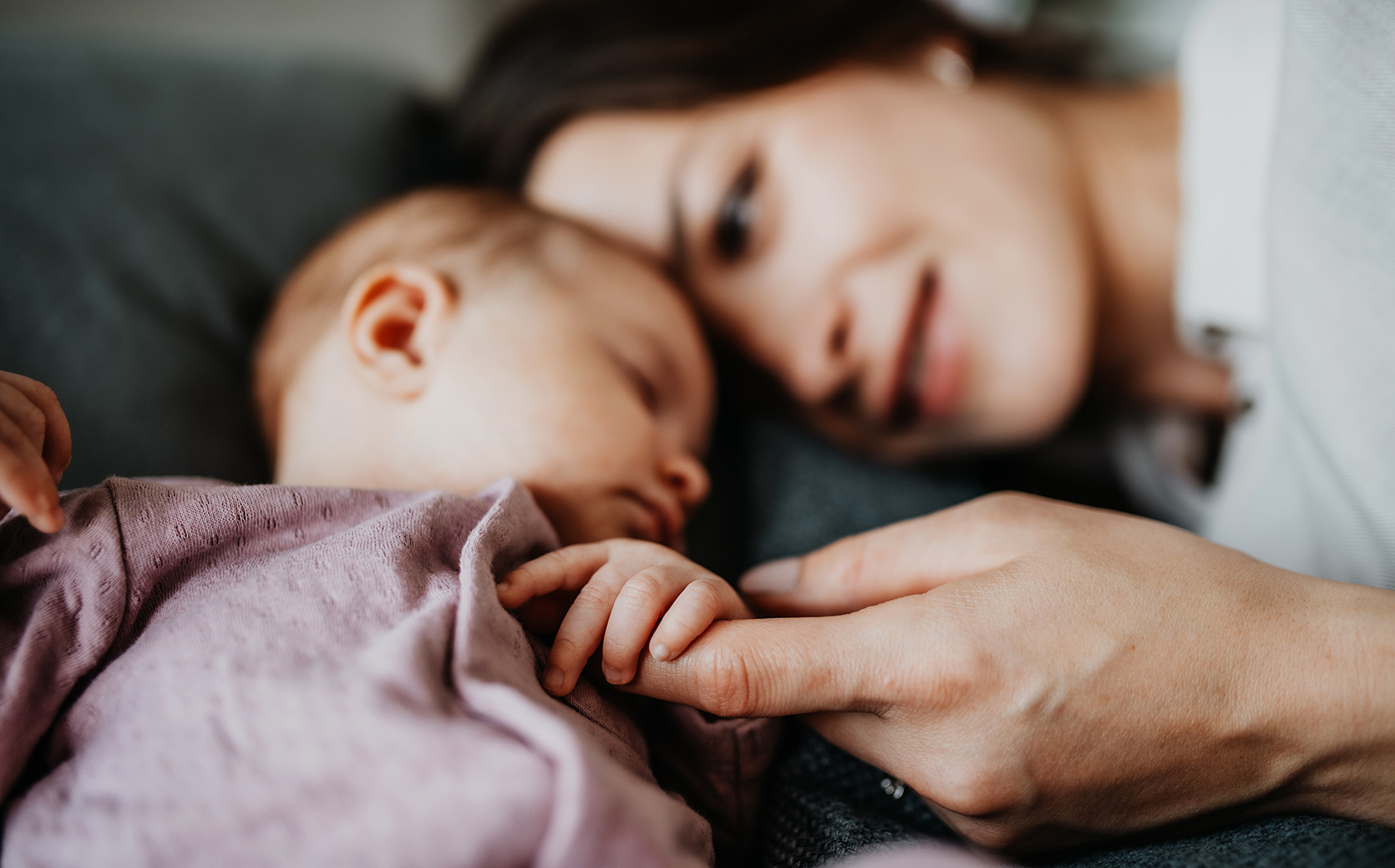Jak ubrać niemowlę do spania?
Spis treści:
Co jest ważne przy ubieraniu dziecka do snu
Ubranie niemowlaka do spania nie jest prostym zadaniem. Musimy uwzględnić kilka ważnych zasad.
- Bezpieczeństwo. Elementy garderoby nie mogą stanowić zagrożenia dla dziecka. Jak zatem ubrać niemowlaka do spania? Priorytetowy jest brak elementów, które mogą odpaść i zostać połknięte. Zwróć także uwagę np. na wiszące nitki – mogą się one owinąć wokół palców dziecka, powodując niedokrwienie tej części ciała. To może być bardzo niebezpieczne!
- Wygoda. Ubranie dla dziecka nie powinno mieć uwierających elementów, dużych guzików, naszytych grubych aplikacji. Pamiętaj, że niemowlę podczas snu może się poruszać i przekręcać.
- Temperatura. Ubranie dla niemowlaka do spania powinno być dostosowane do temperatury w pomieszczeniu. Nie licz na kołderkę! Po pierwsze, maluch mógłby się w niej zaplątać lub zakryć razem z głową, co może spowodować niedotlenienie. Poza tym dzieci się wiercą i zrzucają z siebie wszelkie kocyki i kołdry. Jest to istotne zwłaszcza zimą, bo zmarznięte dziecko będzie się wybudzać i płakać. Pamiętaj jednak o tym, że przegrzane dziecko również śpi niespokojnie.
Jakie tkaniny są najlepsze na noc dla dziecka
Dobór tkanin, z jakich uszyte są ubranka dziecięce, zależy od pory roku. Oto garść uniwersalnych porad:
- Materiały muszą być zdrowe i bezpieczne, naturalne, miękkie i atestowane.
- Weryfikuj oznaczenia, nie kupuj z niesprawdzonych źródeł, np. w sklepach z tanią odzieżą z Chin. Poza Europą nie są przestrzegane odpowiednie normy. Oznacza to, że np. barwniki mogą być uczulające, a nawet toksyczne, zaś tkaniny sztuczne, zawierające chemikalia, które szkodzą. Pamiętaj, że skóra dzieci jest delikatniejsza i wrażliwsza niż skóra dorosłych.
- Sprawdzaj metki, oznaczenia, patrz, czy tekstylia są antyalergiczne, z symbolem gwarantującym brak szkodliwych środków w produkcie.
- Ubranie niemowlaka do snu i jego otoczenie w czasie wypoczynku powinny mieć stonowane, jasne kolory. Choć dzieci dopiero uczą się rozróżniania barw, to delikatne pastele działają korzystniej na wyciszenie i emocje.
Optymalne tkaniny do ubrania dziecka do spania to:
- bawełna,
- polar – może być różnej gramatury, w zależności od tego, czy ubierasz niemowlę do snu zimą czy latem,
- włókna bambusowe – sprawdzają się jako materiały, z których są szyte śpiworki. Bambus ma wiele zalet, m.in. sprzyja termoregulacji, więc jest doskonałym pomysłem na ubranko do spania. Mikropory w tej tkaninie pochłaniają wilgoć, zatem maluch nie będzie się pocił. To tkanina antystatyczna, odpowiednia także dla alergików,
- len – jest antystatyczny i antyalergiczny, uważany za materiał doskonały na lato. Jego minusem jest jednak szorstkość, dlatego w pierwszych dniach i tygodniach postaw przede wszystkim na miękką bawełnę.
Jak ubrać niemowlaka do spania
Oczywiście rodzice uwielbiają słodkie, urocze ubranka z mnóstwem detali. Jeśli jednak chodzi o spanie, należy postawić na zdrowie, komfort i bezpieczeństwo. Skóra maluchów jest szczególnie delikatna, więc trzeba o nią zadbać wyjątkowo starannie. W zależności od tego, czy jest lato, czy zima, sięgajmy po inne kroje i materiały.
- Jak ubrać niemowlę do spania latem
Nie zawsze mamy w domu klimatyzację, a latem noce bywają gorące. Nawet jeśli stosujemy domowe metody ochładzania pomieszczeń, upał może się dawać domownikom we znaki. Jak zatem ubrać niemowlę do spania latem?
Postaw na cienkie, bawełniane ubranka. Nie zakładaj skarpetek ani tym bardziej – o zgrozo! – czapeczki. Pamiętaj, że przegrzane dziecko śpi niespokojnie. Wystarczą krótkie rękawki i krótkie nogawki, np. cienki rampers. Jeśli nie wiesz, jak ubierać noworodka latem do spania, nie bój się pytać położnej, która będzie Was odwiedzać. W gorące noce ubieraj po prostu… jak najlżej. W czasie fali upałów wystarczająca może się okazać sama pieluszka.
- Jak ubrać niemowlę do spania zimą
Pamiętaj, żeby nie przegrzewać pomieszczeń! Wiele osób ma do tego tendencje. Tymczasem optymalna temperatura w pomieszczeniach powinna wynosić 18-22 stopnie, nie więcej. Przegrzewanie działa niekorzystnie na organizm, m.in. na układ odpornościowy, może również powodować zmiany skórne, potówki, zaostrzenie AZS i inne dolegliwości. Przegrzewanie może nawet zwiększać ryzyko śmierci łóżeczkowej. Jeśli chcemy koniecznie okryć niemowlaka, najbezpieczniejsze są śpiworki, które nie przesuwają się na jego ciele.
Słynne czapeczki, które wielu dorosłym wydają się nieodzowne, nawet zimą w domu nie są potrzebne. W chłodniejsze noce wystarczy bawełniany pajacyk. Jeśli nie wiemy, jak ubrać dziecko do śpiworka do spania, spójrzmy… na siebie. Śpiąc pod kołdrą, nie potrzebujemy dodatkowych bluz ani ciepłych dresów, więc nie fundujmy maluchom nocnego przegrzewania.
Skarpetki na noc powinny być pojedyncze, niekrępujące ruchów. Dobrym pomysłem są pajacyki czy śpioszki, które mają pełne, zabudowane nóżki. Rękawki ubranek, czy to body, czy pajaca, zimą powinny być długie.
- Ubieranie wcześniaków
Wyjątek od powyższych zasad to dzieci urodzone przed terminem, które mogą mieć problemy z utrzymywaniem prawidłowej ciepłoty ciała. Neonatolog podpowie, jak zadbać o wcześniaka.
Jak rozpoznać, że dziecku jest za ciepło
Temperaturę dziecka możesz sprawdzić na jego karku: ciepły, zimny, a może spocony? To będzie odpowiedź na pytanie, czy ubranie Twojego dziecka jest odpowiednie do spania.
U dzieci przegrzanych pojawiają się wysypki, zmiany skórne, potówki. Mogą pojawić się także pobudzenie, nerwowość, płaczliwość. Jeżeli w pomieszczeniu jest za ciepło, może dojść także do przesuszenia śluzówek nosa.
To, czy temperatura ciała twojego dziecka nie wzrosła, możesz również zweryfikować za pomocą termometru. Jeśli po zdjęciu ubrań podwyższona ciepłota się utrzymuje, być może dziecko zmaga się z infekcją.

Polecamy
Sen niemowlaka. Ile powinno spać dziecko do 1. roku życia?
Dziecko w 1. roku życia powinno przesypiać większość doby, bo sen jest niezbędny do jego prawidłowego rozwoju. Oczywiście chciałybyśmy, by maluch spał tyle, ile wskazują poradniki, ale codzienność bywa zupełnie inna. Na sen niemowlaka ma wpływ wiele czynników, które możemy wyeliminować, by poprawić jakość życia całej rodziny.
Jak rozpoznać, że dziecku jest za zimno
Jeśli nie wiemy, jak dobrze ubrać dziecko do spania, sprawdźmy, czy wybrane ubranie pozwala utrzymać odpowiednią temperaturę ciała. Wbrew obawom rodziców dłonie i stópki dzieci mogą być chłodne i nie znaczy to, że maluchowi jest zimno.
Optymalnym miejscem weryfikacji, czy dziecko jest ciepło ubrane do snu, jest jego kark. Nawet „letni”, a nie gorący karczek wskazuje, że niemowlęciu jest dobrze, jeśli chodzi o temperaturę. Zmarznięte dzieci wybudzają się lub przeciwnie – stają się zbyt senne i apatyczne.
Czy do spania nieodzowna jest wręcz mityczna czapeczka dla dziecka? Szczególnie noworodki są tak opatulane. Czy słusznie?
– W domu nie zakładamy czapeczki w ogóle, bo dziecku jest tak samo ciepło jak dorosłemu. Zaleca się, żeby w ogóle nie dopuszczać do przegrzania noworodka. Jeśli jest utrzymana normalna temperatura pokojowa, to nie trzeba czapeczki – mówi położna Dominika Mazur.
Maluchy śpią nie tylko w domu, ale i w wózku na spacerach. Jak wówczas ubrać dziecko, żeby nie było mu za chłodno?
– Ubierając dziecko na zewnątrz, stosujemy te same zasady co u dorosłych. Można ewentualnie zabrać dodatkową bluzkę, ale nie ubierać malucha grubiej. Jeśli dziecko ma ciepły kark, to znak, że jest mu ciepło, nawet jeśli nam się wydaje, że jest ubrane za cienko. Jeśli kark będzie zimny, to trzeba dziecko czymś dogrzać. Ale może być tak, że nasza pociecha ma zimne dłonie lub stopy i to jest zupełnie normalne – wyjaśnia Dominika Mazur.








































